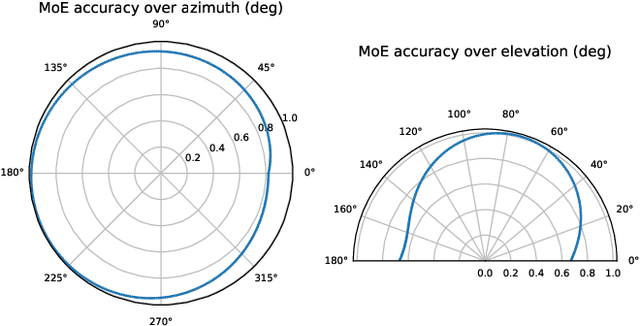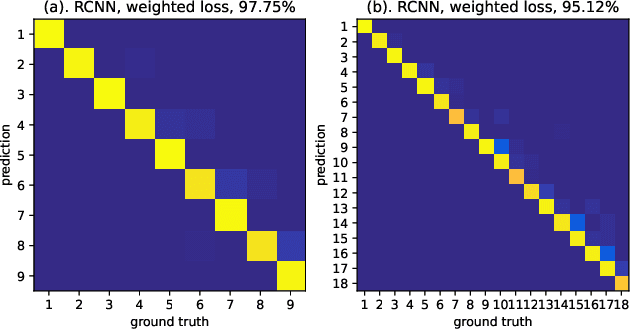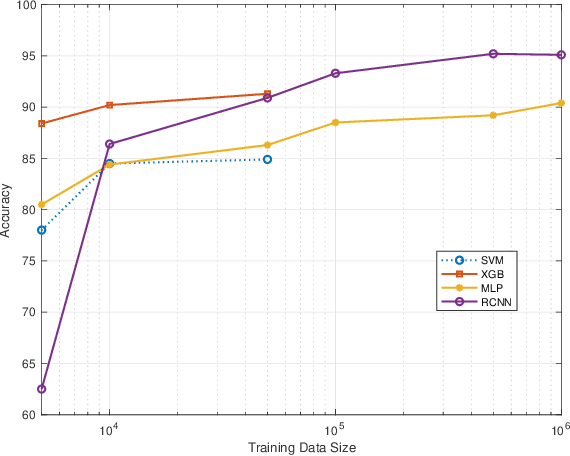Jianyuan Yu
Perry
Model Order Estimation in the Presence of multipath Interference using Residual Convolutional Neural Networks
Sep 01, 2022



Abstract:Model order estimation (MOE) is often a pre-requisite for Direction of Arrival (DoA) estimation. Due to limits imposed by array geometry, it is typically not possible to estimate spatial parameters for an arbitrary number of sources; an estimate of the signal model is usually required. MOE is the process of selecting the most likely signal model from several candidates. While classic methods fail at MOE in the presence of coherent multipath interference, data-driven supervised learning models can solve this problem. Instead of the classic MLP (Multiple Layer Perceptions) or CNN (Convolutional Neural Networks) architectures, we propose the application of Residual Convolutional Neural Networks (RCNN), with grouped symmetric kernel filters to deliver state-of-art estimation accuracy of up to 95.2\% in the presence of coherent multipath, and a weighted loss function to eliminate underestimation error of the model order. We show the benefit of the approach by demonstrating its impact on an overall signal processing flow that determines the number of total signals received by the array, the number of independent sources, and the association of each of the paths with those sources . Moreover, we show that the proposed estimator provides accurate performance over a variety of array types, can identify the overloaded scenario, and ultimately provides strong DoA estimation and signal association performance.
Multi-Modal Recurrent Fusion for Indoor Localization
Mar 02, 2022



Abstract:This paper considers indoor localization using multi-modal wireless signals including Wi-Fi, inertial measurement unit (IMU), and ultra-wideband (UWB). By formulating the localization as a multi-modal sequence regression problem, a multi-stream recurrent fusion method is proposed to combine the current hidden state of each modality in the context of recurrent neural networks while accounting for the modality uncertainty which is directly learned from its own immediate past states. The proposed method was evaluated on the large-scale SPAWC2021 multi-modal localization dataset and compared with a wide range of baseline methods including the trilateration method, traditional fingerprinting methods, and convolution network-based methods.
Multi-Band Wi-Fi Sensing with Matched Feature Granularity
Dec 28, 2021



Abstract:Complementary to the fine-grained channel state information (CSI) from the physical layer and coarse-grained received signal strength indicator (RSSI) measurements, the mid-grained spatial beam attributes (e.g., beam SNR) that are available at millimeter-wave (mmWave) bands during the mandatory beam training phase can be repurposed for Wi-Fi sensing applications. In this paper, we propose a multi-band Wi-Fi fusion method for Wi-Fi sensing that hierarchically fuses the features from both the fine-grained CSI at sub-6 GHz and the mid-grained beam SNR at 60 GHz in a granularity matching framework. The granularity matching is realized by pairing two feature maps from the CSI and beam SNR at different granularity levels and linearly combining all paired feature maps into a fused feature map with learnable weights. To further address the issue of limited labeled training data, we propose an autoencoder-based multi-band Wi-Fi fusion network that can be pre-trained in an unsupervised fashion. Once the autoencoder-based fusion network is pre-trained, we detach the decoders and append multi-task sensing heads to the fused feature map by fine-tuning the fusion block and re-training the multi-task heads from the scratch. The multi-band Wi-Fi fusion framework is thoroughly validated by in-house experimental Wi-Fi sensing datasets spanning three tasks: 1) pose recognition; 2) occupancy sensing; and 3) indoor localization. Comparison to four baseline methods (i.e., CSI-only, beam SNR-only, input fusion, and feature fusion) demonstrates the granularity matching improves the multi-task sensing performance. Quantitative performance is evaluated as a function of the number of labeled training data, latent space dimension, and fine-tuning learning rates.
Direction of Arrival Estimation for a Vector Sensor Using Deep Neural Networks
Apr 12, 2020



Abstract:A vector sensor, a type of sensor array with six collocated antennas to measure all electromagnetic field components of incident waves, has been shown to be advantageous in estimating the angle of arrival and polarization of the incident sources. While angle estimation with machine learning for linear arrays has been well studied, there has not been a similar solution for the vector sensor. In this paper, we propose neural networks to determine the number of the sources and estimate the angle of arrival of each source, based on the covariance matrix extracted from received data. Also, we provide a solution for matching output angles to corresponding sources and examine the error distributions with this method. The results show that neural networks can achieve reasonably accurate estimation with up to 5 sources, especially if the field-of-view is limited.
Centimeter-Level Indoor Localization using Channel State Information with Recurrent Neural Networks
Feb 04, 2020



Abstract:Modern techniques in the Internet of Things or autonomous driving require more accuracy positioning ever. Classic location techniques mainly adapt to outdoor scenarios, while they do not meet the requirement of indoor cases with multiple paths. Meanwhile as a feature robust to noise and time variations, Channel State Information (CSI) has shown its advantages over Received Signal Strength Indicator (RSSI) at more accurate positioning. To this end, this paper proposes the neural network method to estimate the centimeter-level indoor positioning with real CSI data collected from linear antennas. It utilizes an amplitude of channel response or a correlation matrix as the input, which can highly reduce the data size and suppress the noise. Also, it makes use of the consistency in the user motion trajectory via Recurrent Neural Network (RNN) and signal-noise ratio (SNR) information, which can further improve the estimation accuracy, especially in small datasize learning. These contributions all benefit the efficiency of the neural network, based on the results with other classic supervised learning methods.
Multiple Angles of Arrival Estimation using Neural Networks
Feb 03, 2020



Abstract:MUltiple SIgnal Classification (MUSIC) and Estimation of signal parameters via rotational via rotational invariance (ESPRIT) has been widely used in super resolution direction of arrival estimation (DoA) in both Uniform Linear Arrays (ULA) or Uniform Circular Arrays (UCA). However, problems become challenging when the number of source signal increase, MUSIC suffer from computation complexity when finding the peaks, while ESPRIT may not robust to array geometry offset. Therefore, Neural Network become a potential solution. In this paper, we propose a neural network to estimate the azimuth and elevation angles, based on the correlated matrix extracted from received data. Also, a serial scheme is listed to estimate multiple signals cases. The result shows the neural network can achieve an accurate estimation under low SNR and deal with multiple signals.
Interference Classification Using Deep Neural Networks
Feb 03, 2020



Abstract:The recent success in implementing supervised learning to classify modulation types suggests that other problems akin to modulation classification would eventually benefit from that implementation. One of these problems is classifying the interference type added to a signal-of-interest, also known as interference classification. In this paper, we propose an interference classification method using a deep neural network. We generate five distinct types of interfering signals then use both the power-spectral density (PSD) and the cyclic spectrum of the received signal as input features to the network. The computer experiments reveal that using the received signal PSD outperforms using its cyclic spectrum in terms of accuracy. In addition, the same experiments show that the feed-forward networks yield better accuracy than classic methods. The proposed classifier aids the subsequent stage in the receiver chain with choosing the appropriate mitigation algorithm and also can coexist with modulation-classification methods to further improve the classifier accuracy.
 Add to Chrome
Add to Chrome Add to Firefox
Add to Firefox Add to Edge
Add to Edge